Effects of Mindfulness for Performance Programme on Actual Performance in Ecological Sport Context: Two Studies in Basketball and Table Tennis
Abstract
1. Introduction
2. Study 1: Effects of MFP on Mindfulness Skills and Free-Throw Performance in Basketball
2.1. Method
2.1.1. Participants
2.1.2. Design
2.1.3. Procedure
2.1.4. Measures
2.1.5. Data Analysis
2.2. Results
2.2.1. Pre-Intervention Comparisons
2.2.2. Effects of MFP on Mindfulness Skills
2.2.3. Free-Throw Performance
3. Study 2: Effects of MFP on Mindfulness Skills, Focus of Attention, and Performance in Competition in Table Tennis
3.1. Method
3.1.1. Participants
3.1.2. Procedure
3.1.3. Measures
3.1.4. Data Analysis
3.2. Results
3.2.1. Adherence to the Programme
3.2.2. Effects of MFP on Mindfulness Skills
3.2.3. Effects of MFP on Focus of Attention
3.2.4. Effects of MFP on Performance
3.2.5. Results of the Cases 1 and 10
4. Discussion
5. Conclusions
6. Limitations and Future Research
Author Contributions
Funding
Institutional Review Board Statement
Informed Consent Statement
Data Availability Statement
Acknowledgments
Conflicts of Interest
References
- Lindsay, E.K.; Creswell, J.D. Mechanisms of Mindfulness Training: Monitor and Acceptance Theory (MAT). Clin. Psychol. Rev. 2017, 51, 48–59. [Google Scholar] [CrossRef]
- Birrer, D.; Rothlin, P.; Morgan, G. Mindfulness to Enhance Athletic Performance: Theoretical Considerations and Possible Impact Mechanisms. Mindfulness 2012, 3, 235–246. [Google Scholar] [CrossRef]
- Gardner, F.L.; Moore, Z.E. Mindfulness-based and acceptance-based interventions in sport and performance contexts. Curr. Opin. Pychol. 2017, 16, 180–184. [Google Scholar] [CrossRef] [PubMed]
- Rothlin, P.; Birrer, D. Mental Training in Group Settings: Intervention Protocols of a Mindfulness and Acceptance Based and a Psychological Skills Training Program. J. Sport. Psychol. Action 2019, 11, 103–114. [Google Scholar] [CrossRef]
- Buhlmayer, L.; Birrer, D.; Röthlin, P.; Faude, O.; Donath, L. Effects of Mindfulness Practice on Performance Relevant Parameters and Performance Outcomes in Sports: A Meta-Analytical Review. Sports Med. 2017, 47, 2309–2321. [Google Scholar] [CrossRef] [PubMed]
- Noetel, M.; Ciarrochi, J.; Van Zanden, B.; Lonsdale, C. Mindfulness and Acceptance Approaches to Sporting Performance Enhancement: A Systematic Review. Int. J. Sport Exerc. Psychol. 2019, 12, 139–175. [Google Scholar] [CrossRef]
- Sappington, R.; Longshore, K. Systematically Reviewing the Efficacy of Mindfulness-Based Interventions for Enhanced Athletic Performance. J. Clin. Sport Psychol. 2015, 9, 232–262. [Google Scholar] [CrossRef]
- Bernier, M.; Thienot, E.; Codron, R.; Fournier, J.F. Mindfulness and Acceptance Approaches in Sport Performance. J. Clin. Sport Psychol. 2009, 3, 320–333. [Google Scholar] [CrossRef]
- Mardon, N.; Richards, H.; Martindale, A. The Effect of Mindfulness Training on Attention and Performance in National-Level Swimmers: An Exploratory Investigation. J. Sport Psychol. 2016, 30, 131–140. [Google Scholar] [CrossRef]
- Josefsson, T.; Ivarson, A.; Gustafsson, H.; Stenling, A.; Lindwall, M.; Tornberg, R.; Boroy, J. Effects of Mindfulness Acceptance Commitment (MAC) on Sport Specific Dispositional Mindfulness, Emotion Regulation, and Self-Rated Athletic Performance in a Multiple Sport Population: An RCT Study. Mindfulness 2019, 10, 1518–1529. [Google Scholar] [CrossRef]
- Scott-Hamilton, J.; Schutte, N.S. The Role of Adherence in the Effects of a Mindfulness Intervention for Competitive Athletes: Changes in Mindfulness, Flow, Pessimism, and Anxiety. J. Clin. Sport Psychol. 2016, 10, 99–117. [Google Scholar] [CrossRef]
- Solberg, E.E.; Ingjer, F.; Holen, A.; Sundgot-Borgen, J.; Nilsson, S.; Holme, I. Stress Reactivity to and Recovery from a Standardised Exercise Bout: A Study of 31 Runners Practising Relaxation Techniques. Br. J. Sports Med. 2000, 34, 268–272. [Google Scholar] [CrossRef]
- Doron, J.; Rouault, Q.; Jubeau, M.; Bernier, M. Integrated Mindfulness Based Intervention: Effect on Mindfulness Skills, Cognitive Interference and Performance Satisfaction of Young Elite Badminton Players. Psychol. Sport Exerc. 2020, 47, 101638. [Google Scholar] [CrossRef]
- John, D.S.; Verma, D.S.K.; Khanna, D.G.L. The Effect of Mindfulness Meditation on HPA-Axis in Pre-Competition Stress in Sports Performance of Elite Shooters: Mindfulness Meditation on HPA-Axis. Natl. J. Integr. Res. Med. 2011, 2, 15–21. [Google Scholar]
- Solberg, E.E.; Berglund, K.A.; Engen, O.; Ekeberg, O.; Loeb, M. The Effect of Meditation on Shooting Performance. Br. J. Sports Med. 1996, 30, 342–346. [Google Scholar] [CrossRef] [PubMed]
- Zhang, C.Q.; Chung, P.K.; Si, G. Assessing Acceptance in Mindfulness with Direct-Worded Items: The Development and Initial Validation of the Athlete Mindfulness Questionnaire. J. Sport Health Sci. 2015, 6, 311–320. [Google Scholar] [CrossRef]
- Shaabani, F.; Naderi, A.; Borella, E.; Calmeiro, L. Does a Brief Mindfulness Intervention Counteract the Detrimental Effects of Ego Depletion in Basketball Free Throw Under Pressure? Sport Exerc. Perform. Psychol. 2020, 9, 197–215. [Google Scholar] [CrossRef]
- Wolch, N.J.; Arthur-Cameselle, J.N.; Keeler, L.A.; Suprak, D.N. The Effects of a Brief Mindfulness Intervention on Basketball Free-Throw Shooting Performance under Pressure. J. Appl. Sport Psychol. 2020, 33, 510–526. [Google Scholar] [CrossRef]
- Hoja, S.; Jansen, P. Mindfulness-based intervention for tennis players: A quasi-experimental pilot study. BMJ Open Sport Exerc. Med. 2019, 5, e000584. [Google Scholar] [CrossRef] [PubMed]
- Perry, J.E.; Ross, M.; Weinstock, J.; Weaver, T. Efficacy of a Brief Mindfulness Intervention to Prevent Athletic Task Performance Deterioration: A Randomized Controlled Trial. J. Sport Psychol. 2017, 31, 410–420. [Google Scholar] [CrossRef]
- Jones, B.J.; Kaur, S.; Miller, M.; Spencer, R.M.C. Mindfulness-Based Stress Reduction Benefits Psychological Well-Being, Sleep Quality, and Athletic Performance in Female Collegiate Rowers. Front. Psychol. 2020, 11, 572980. [Google Scholar] [CrossRef] [PubMed]
- Nien, J.T.; Wu, C.H.; Yang, K.T.; Cho, Y.M.; Chu, C.H.; Chang, Y.K.; Zhou, C. Mindfulness Training Enhances Endurance Performance and Executive Functions in Athletes: An Event-Related Potential Study. Neural Plast. 2020, 2020, 8213710. [Google Scholar] [CrossRef] [PubMed]
- Bernier, M.; Thienot, E.; Pelosse, E.; Fournier, J. Effects and Underlying Processes of a Mindfulness-Based Intervention with Young Elite Figure Skaters: Two Case Studies. J. Sport Psychol. 2014, 28, 302–315. [Google Scholar] [CrossRef]
- Gardner, F.L.; Moore, Z.E. The Psychology of Enhancing Human Performance: The Mindfulness Acceptance Commitment (MAC) Approach; Springer Publishing Company: New York, NY, USA, 2007. [Google Scholar]
- Kaufman, K.A.; Glass, C.R.; Arnkoff, D.B. Evaluation of Mindful Sport Performance Enhancement (MSPE): A New Approach to Promote Flow in Athletes. J. Clin. Sport Psychol. 2009, 3, 334–356. [Google Scholar] [CrossRef]
- Baltzell, A.; Akhtar, V.L. Mindfulness Meditation Training for Sport (MMTS) Intervention: Impact of MMTS with Division I Female Athletes. J. Happiness Well-Being 2014, 2, 160–173. [Google Scholar]
- Fournier, J. Mindfulness and mental preparation. In Advancements in Mental Skills Training; Bertollo, M., Filho, E., Terry, P., Eds.; Routledge: London, UK, 2021; pp. 57–59. [Google Scholar]
- Bahram, A. It is Time to Move from Motor Behavior and Sport Psychology Labs to Naturalistic Environments. Int. J. Mot. Control Learn. 2020, 2, 1–4. [Google Scholar] [CrossRef]
- Bernier, M.; Codron, R.; Thienot, E.; Fournier, J.F. The Attentional Focus of Expert Golfers in Training and Competition: A Naturalistic Investigation. J. Appl. Sport Psychol. 2011, 23, 326–341. [Google Scholar] [CrossRef]
- Bernier, M.; Trottier, C.; Thienot, E.; Fournier, J. An Investigation of Attentional Foci and their Temporal Patterns: A Naturalistic Study in Expert Figure Skaters. Sport Psychol. 2016, 30, 256–266. [Google Scholar] [CrossRef]
- Collins, D.; Carson, H.J.; Toner, J. Letter to the Editor Concerning the Article “Performance of Gymnastics Skill Benefits from an External Focus of Attention” by Abdollahipour, Wulf, Psotta& Nieto (2015). J. Sports Sci. 2016, 34, 1288–1292. [Google Scholar] [CrossRef]
- Durand-Bush, N.; Salmela, J.H.; Green-Demers, I. The Ottawa Mental Skills Assessment Tool (OMSAT-3*). J. Sport Psychol. 2001, 15, 1–19. [Google Scholar] [CrossRef]
- Jha, A.P.; Witkin, J.E.; Morrison, A.B.; Rostrup, N.; Stanley, E. Short-Form Mindfulness Training Protects Against Working Memory Degradation Over High-Demand Intervals. J. Cogn. Enhanc. 2017, 1, 154–171. [Google Scholar] [CrossRef]
- Rooks, J.D.; Morrison, A.B.; Goolsarran, M.; Rogers, S.L.; Jha, A.P. “We Are Talking About Practice”: The Influence of Mindfulness vs. Relaxation Training on Athletes’ Attention and Well-Being Over High-Demand Intervals. J. Cogn. Enhanc. 2017, 1, 141–153. [Google Scholar] [CrossRef]
- Zanesco, A.P.; Denkova, E.; Rogers, S.L.; MacNulty, W.K.; Jha, A.P. Mindfulness training as cognitive training in high-demand cohorts: An initial study in elite military servicemembers. Prog. Brain Res. 2019, 244, 323–354. [Google Scholar] [CrossRef]
- Goisbault, M.; Lienhart, N.; Martinent, G.; Doron, J. An Integrated Mindfulness and Acceptance-Based Program for Young Elite Female Basketball Players: Exploratory Study of How it Works and Whom it Works Best. Psychol. Sport Exerc. 2022, 60, 102157. [Google Scholar] [CrossRef]
- Thienot, E.; Jackson, B.; Dimmock, J.; Grove, J.R.; Bernier, M.; Fournier, J.F. Development and Preliminary Validation of the Mindfulness Inventory for Sport. Psychol. Sport Exerc. 2014, 15, 72–80. [Google Scholar] [CrossRef]
- JASP Team. JASP Computer Software Version 0.16.2; JASP Team: Amsterdam, The Netherlands, 2022. [Google Scholar]
- Perone, M.; Hursh, D.E. Single-Case Experimental Designs. In APA Handbook of Behavior Analysis, Vol. 1: Methods and Principles; Madden, G.J., Dube, W.V., Hackenberg, T.D., Hanley, G.P., Lattal, K.A., Eds.; American Psychological Association: Washington, DC, USA, 2013; pp. 107–126. [Google Scholar] [CrossRef]
- Gu, J.; Strauss, C.; Bond, R.; Cavanagh, K. How do Mindfulness-Based Cognitive Therapy and Mindfulness-Based Stress Reduction Improve Mental Health and Wellbeing? A Systematic Review and Meta-Analysis of Mediation Studies. Clin. Psychol. Rev. 2015, 37, 1–12. [Google Scholar] [CrossRef]
- Heeren, A.; Douilliez, C.; Peschard, V.; Debrauwere, L.; Philippot, P. Cross-Cultural Validity of the Five Facets Mindfulness Questionnaire: Adaptation and Validation in a French-Speaking Sample. Eur. Rev. Appl. Psychol. 2011, 61, 147–151. [Google Scholar] [CrossRef]
- Baer, R.A.; Krietemeyer, J. Overview of Mindfulness- and Acceptance-Based Treatment Approaches. In Mindfulness-Based Treatment Approaches: Clinician’s Guide to Evidence Base and Applications; Baer, R.A., Ed.; Elsevier: London, UK, 2006; pp. 3–27. [Google Scholar] [CrossRef]
- Lobo, M.; Moeyaert, M.; Baraldi Cunha, A.; Babik, I. Single-Case Design, Analysis, and Quality Assessment for Intervention Research. J. Neurol. Phys. Ther. 2017, 41, 187–197. [Google Scholar] [CrossRef]
- Ma, H.H. An Alternative Method for Quantitative Synthesis of Single Subject Researches: Percentage of Data Points Exceeding the Median. Behav. Modif. 2006, 30, 598–617. [Google Scholar] [CrossRef]
- Longshore, K.; Sachs, M. Mindfulness Training for Coaches: A Mixed-Method Explatory Study. J. Clin. Sport Psychol. 2015, 9, 116–137. [Google Scholar] [CrossRef]
- Halperin, I.; Vigotsky, A.; Foster, C.; Pyne, D. Strengthening the Practice of Exercise and Sport-Science Research. Int. J. Sports Physiol. Perform. 2018, 13, 127–134. [Google Scholar] [CrossRef] [PubMed]
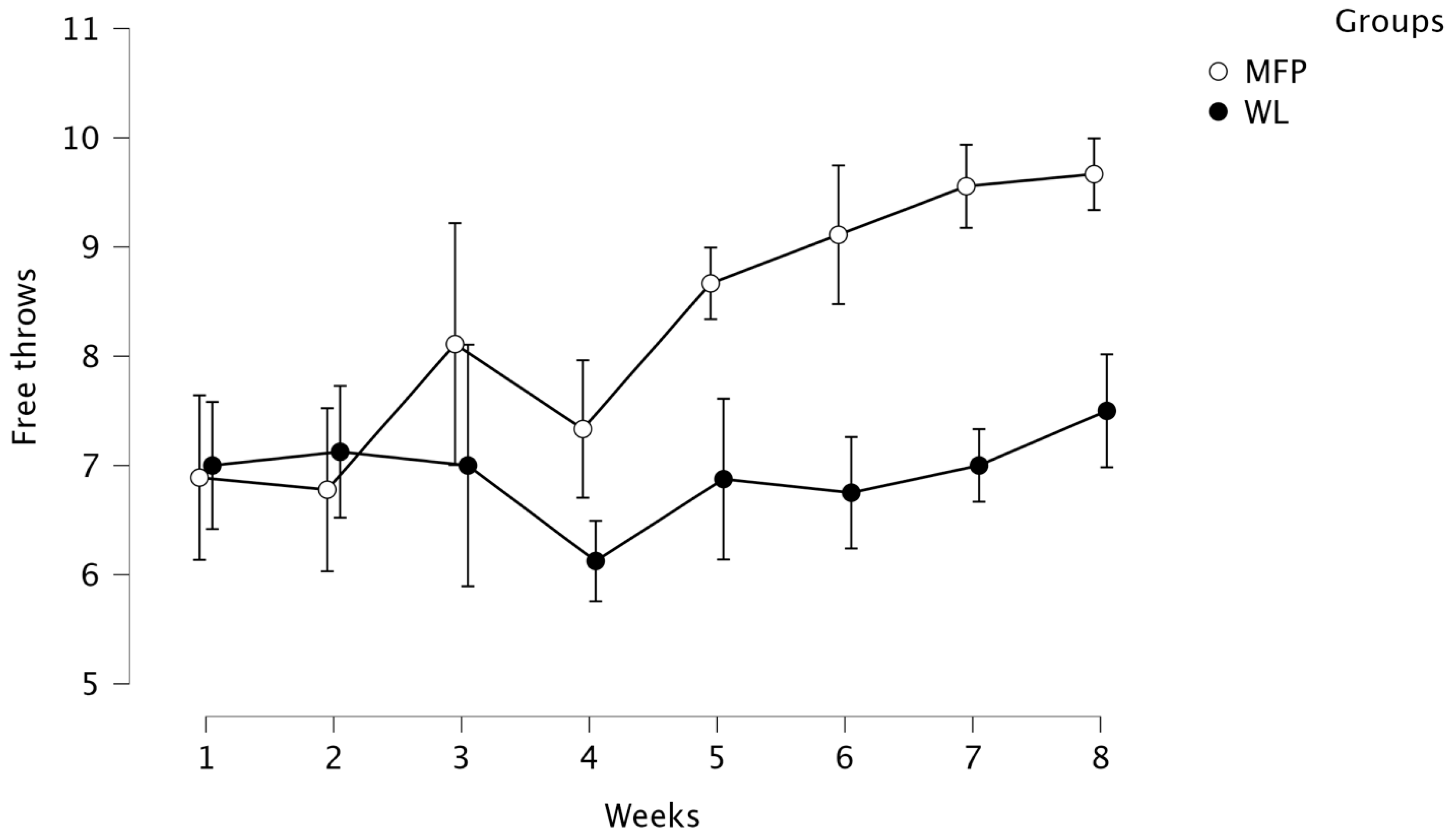
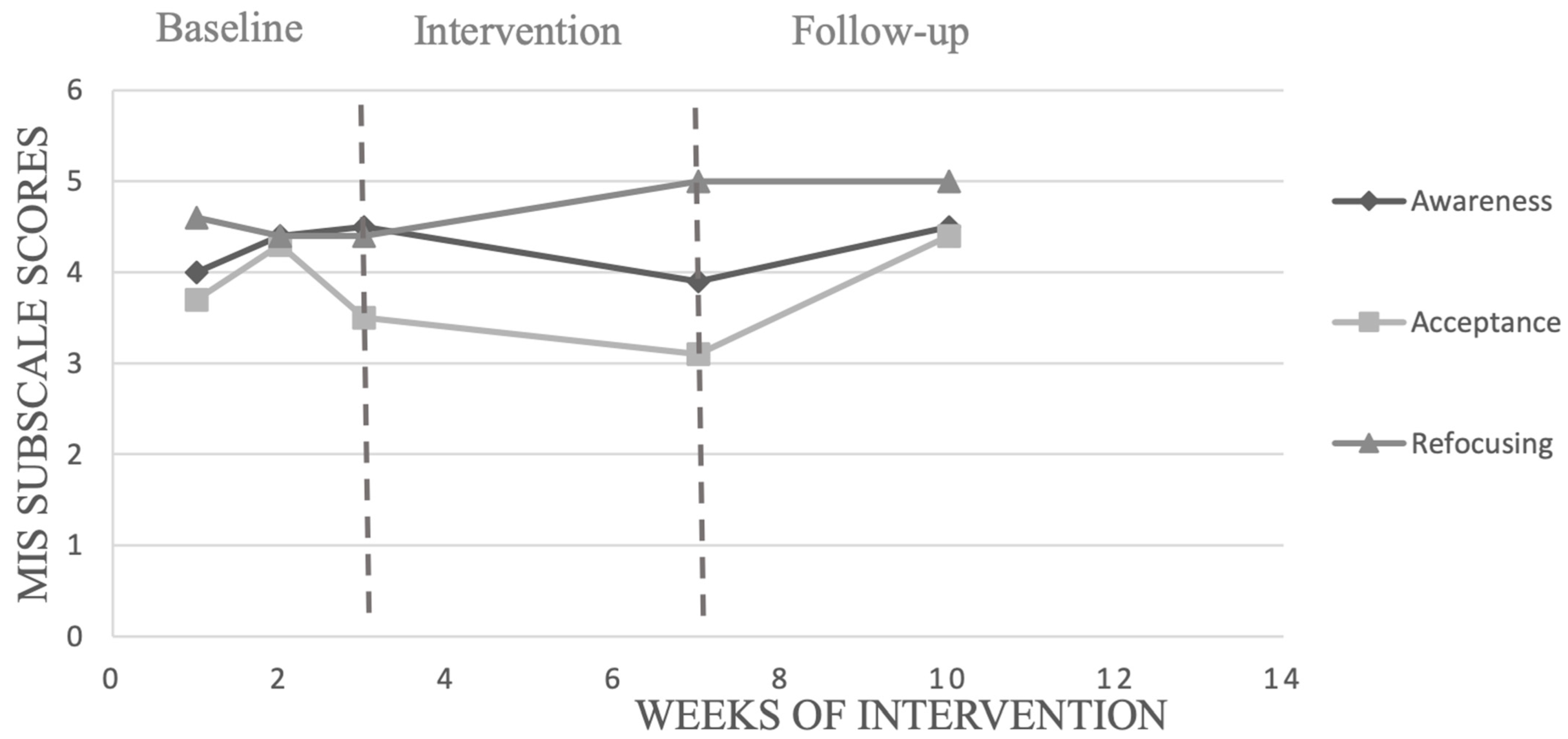
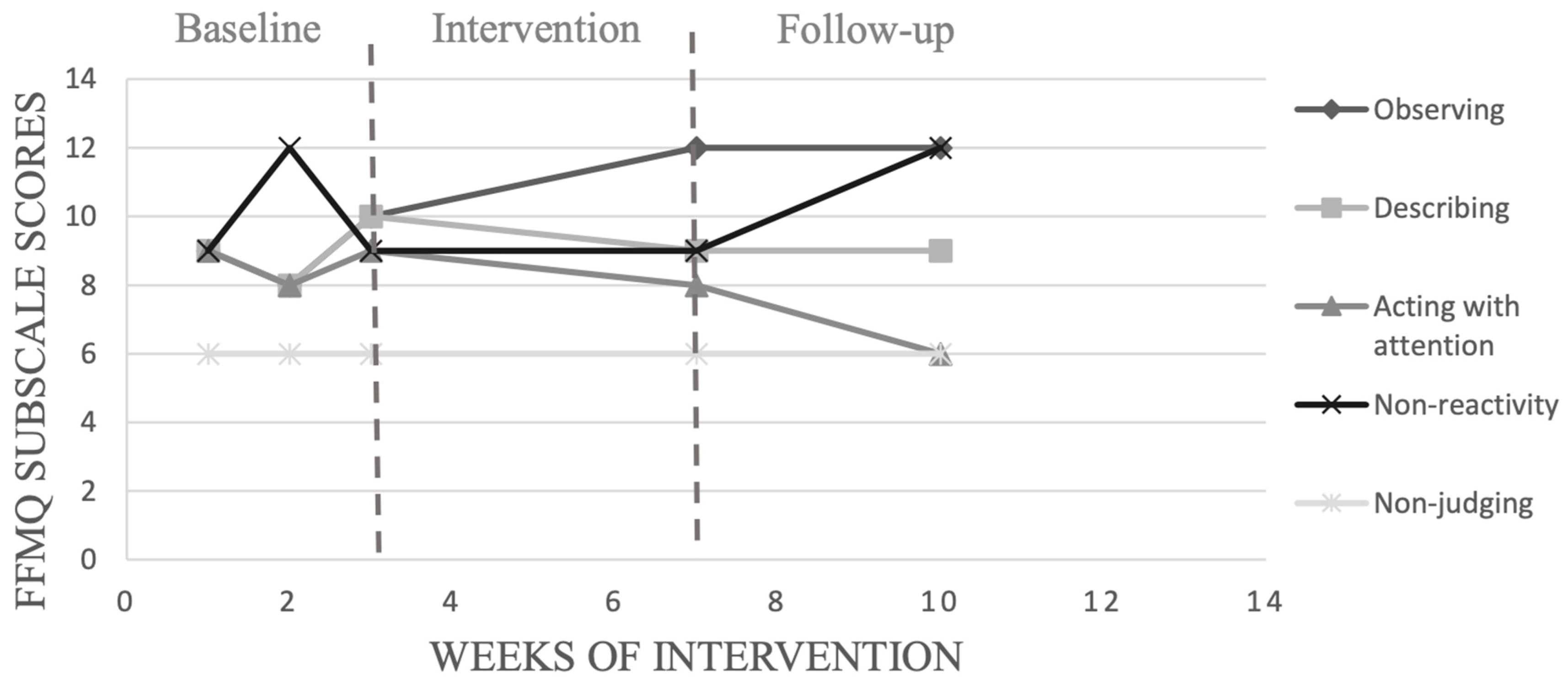
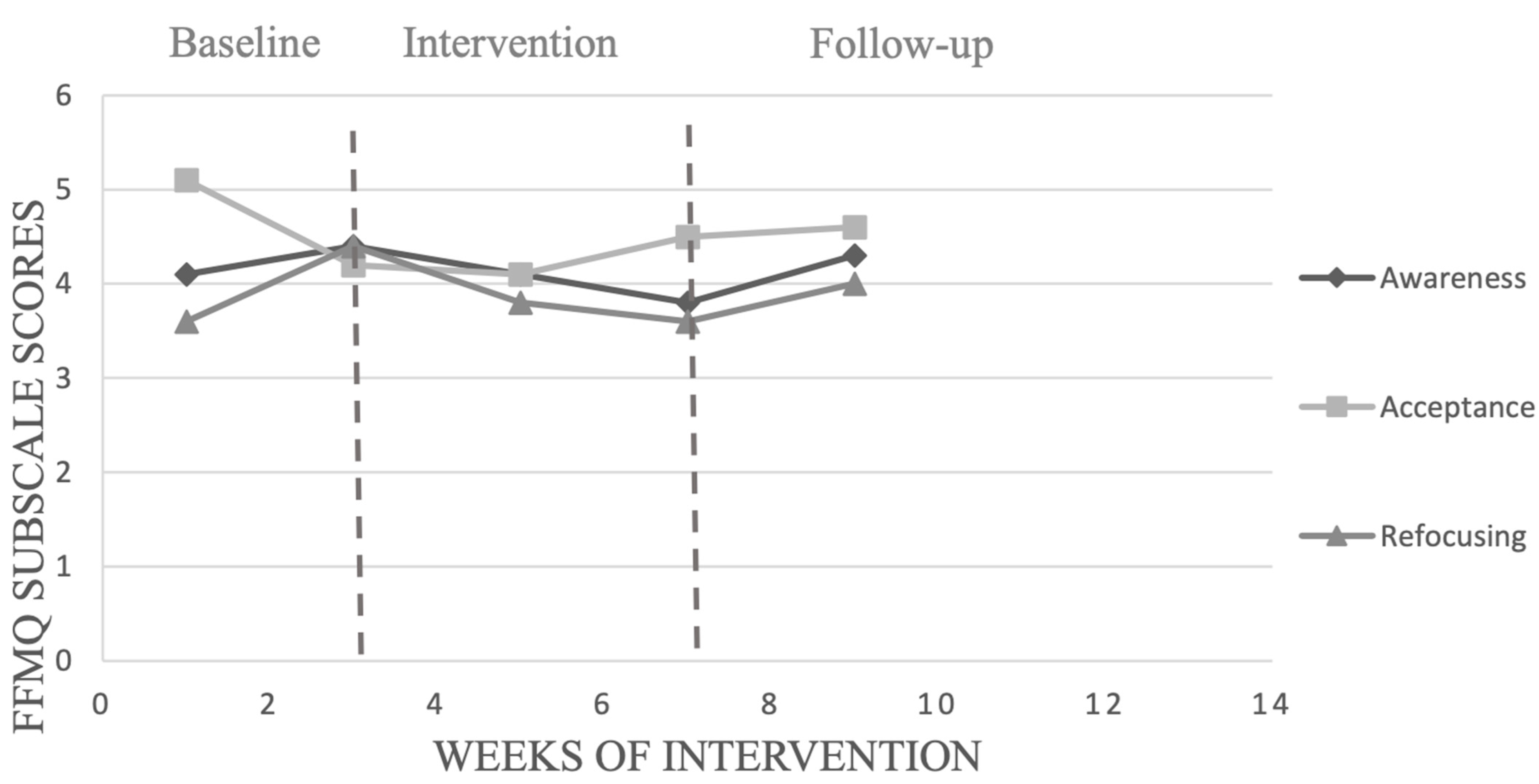
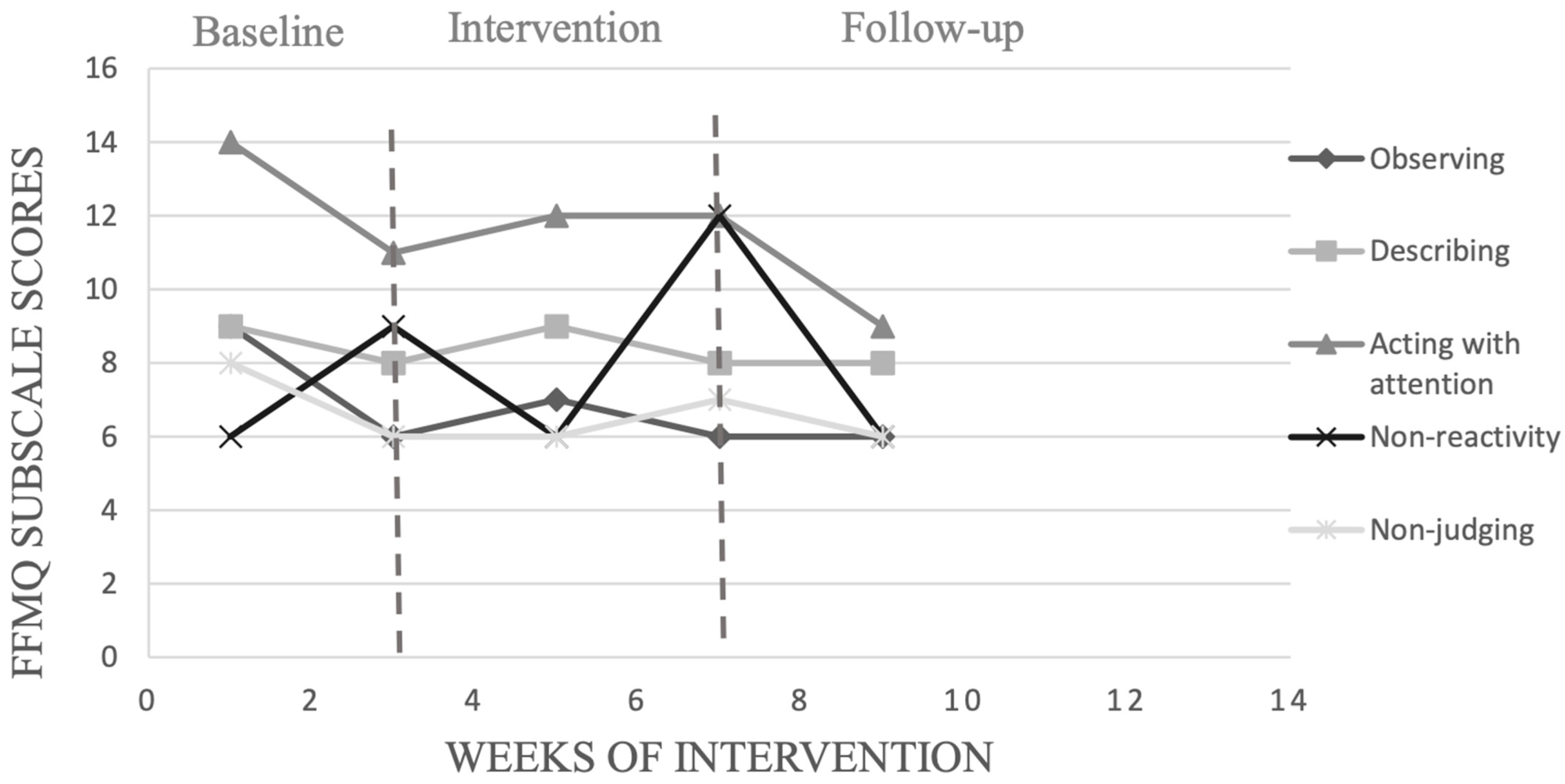
| Weeks | Specific Content for Basketball |
|---|---|
| 1 | Definition of an individualized relevant focus of attention for free throw (for example, the middle of the inner-back side of the rim) to be used before each free-throw shot. Introduction to scans (i.e., ask and answer in your mind the two questions ‘What I am thinking about? What do I feel?’) and to the mindfulness sessions which were presented as focusing on breathing (10 min session in a sitting position to notice distractions and refocus on breathing). |
| 2 | Remind to use focus of attention before each free throw. Mindfulness practice: ‘focusing on breathing while sitting’ sessions. Remind to practice scans everyday. |
| 3 | Remind to use focus of attention before each free throw. Mindfulness practice: ‘focusing on breathing while standing’ sessions. Remind to practice scans and integrate it during basketball session before free throws. |
| 4 | Introduction to acceptance (notice and accept thoughts and feelings as transitory mental events). Presentation of sessions with train, cinema, and clouds metaphors (watch the train of thought/feelings, watch a movie of your mental events, watch clouds carrying your mental events). Emphasis is placed on being an observer and on considering mental events as only mental events. Mindfulness practice: ‘focusing on breathing’ sessions and acceptance sessions based on the metaphors. Request to shorten scan to 2 min and increase the number of scans at the beginning of the routine. |
| 5 | Mindfulness practice: Acceptance sessions based on metaphors and integrated mindfulness sessions, alternating focus on breathing for 2 min and playing basketball for 2 min, repeated 5 times. Request to increase the number of brief scans at the beginning of the routine. |
| 6 | Mindfulness practice: Acceptance sessions based on metaphors and integrated mindfulness sessions, alternating focus on breathing for 1 min and playing basketball for 1 min, repeated 5 times. Request to increase the number of brief scans at the beginning of the routine. |
| MIS | Awareness | Acceptance | Refocusing | |||||||
|---|---|---|---|---|---|---|---|---|---|---|
| T1 | T2 | T3 | T1 | T2 | T3 | T1 | T2 | T3 | ||
| MFP | Mean | 3.4 | 5.1 | 5 | 2.9 | 5.1 | 4.8 | 2.8 | 5.8 | 5.6 |
| SD | 0.8 | 0.2 | 0.2 | 0.8 | 0.2 | 0.4 | 1.1 | 0.3 | 0.3 | |
| WL | Mean | 2.8 | 2.8 | 2.7 | 3.5 | 3 | 3 | 2.3 | 3.3 | 3.3 |
| SD | 0.6 | 0.5 | 0.5 | 1.2 | 1.1 | 1 | 0.9 | 0.8 | 0.9 | |
| Weeks | Specific Content for Table Tennis |
|---|---|
| 1 | Definition of an individualized relevant focus of attention for each player to be used before each service, such as visualizing ball trajectory or focusing on the target. Introduction to scans (i.e., ask and answer in your mind the two questions ‘What I am thinking about? What do I feel?’) and to mindfulness sessions presented as focusing on breathing (10 min session in a sitting position to notice distractions and refocus on breathing). |
| 2 | Remind to use focus of attention in the routine before serving. Mindfulness practice: ‘focusing on breathing while sitting’ sessions. Homework: Practice scans everyday. |
| 3 | Remind to use focus of attention in the routine before serving. Mindfulness practice: ‘focusing on breathing while standing’ sessions. Homework: Practice scan and integrate it during table tennis session in the routine before serving or receiving. |
| 4 | Introduction to acceptance (notice and accept thoughts and feeling as transitory mental events). Presentation of sessions with train, cinema, and clouds metaphors (watch the train of thought/feelings, watch a movie of your mental events, watch clouds carrying your mental events). Emphasis is placed on being an observer and on considering mental events as only mental events. Mindfulness practice: ‘focusing on breathing’ sessions and acceptance sessions based on the metaphors. Homework: Shorten scan to 2 min and increase scan in the routine before serving or receiving. |
| 5 | Mindfulness practice: Acceptance sessions based on metaphors and integrated mindfulness sessions, alternating focus on breathing for 2 min and playing table tennis for 2 min, repeated 5 times. Homework: Increase the number of brief scans in the routine before serving or receiving. |
| 6 | Mindfulness practice: Acceptance sessions based on metaphors and integrated mindfulness sessions, alternating focus on breathing for 1 min and playing table tennis for 1 min, repeated 5 times. Homework: Increase the number of brief scans in the routine before serving or receiving. |
| Participants | Percentage of Adherence |
|---|---|
| P1 | 80% |
| P3 | 80% |
| P4 | 70% |
| P7 | 70% |
| P8 | 70% |
| P9 | 50% |
| P10 | 30% |
| Participants | Observing | Describing | Acting with Awareness | Non-Reaction | Non-Judging |
|---|---|---|---|---|---|
| P1 | 100% | 0% | 0% | 50% | 0% |
| P3 | 25% | 25% | 75% | 0% | 25% |
| P4 | 0% | 100% | 25% | 0% | 100% |
| P7 | 100% | 100% | 66% | 0% | 0% |
| P8 | 33% | 0% | 0% | 0% | 0% |
| P9 | 100% | 33% | 33% | 0% | 0% |
| P10 | 0% | 0% | 0% | 33% | 0% |
| Average | 51.14% | 36.86% | 28.43% | 11.86% | 17.86% |
| Participants | Awareness | Acceptance | Refocusing |
|---|---|---|---|
| P1 | 0% | 50% | 100% |
| P3 | 25% | 50% | 25% |
| P4 | 25% | 50% | 50% |
| P7 | 0% | 60% | 100% |
| P8 | 33,3% | 30% | 100% |
| P9 | 100% | 0% | 66% |
| P10 | 0% | 0% | 33% |
| Average | 26.19% | 34.29% | 67.71% |
| Week 2 | Week 3 | Week 4 | Week 5 | Week 6 |
|---|---|---|---|---|
| 10% | 30% | 50% | 70% | 100% |
| 5% | 15% | 30% | 40% | 50% |
| 8% | 12% | 25% | 40% | 60% |
| 10% | 20% | 40% | 60% | 80% |
| 10% | 20% | 30% | 50% | 80% |
| 5% | 10% | 20% | 40% | 50% |
| 5% | 10% | 15% | 20% | 30% |
| Participants | Before Intervention | End of Intervention | Follow-Up Phase |
|---|---|---|---|
| P1 | 1824 | 1860 | 1881 |
| P3 | 1314 | 1383 | 1396 |
| P4 | 1638 | 1666 | 1681 |
| P7 | 1271 | 1306 | 1320 |
| P8 | 1666 | 1700 | 1730 |
| P9 | 935 | 940 | 960 |
| P10 | 1341 | 1350 | 1345 |
Publisher’s Note: MDPI stays neutral with regard to jurisdictional claims in published maps and institutional affiliations. |
© 2022 by the authors. Licensee MDPI, Basel, Switzerland. This article is an open access article distributed under the terms and conditions of the Creative Commons Attribution (CC BY) license (https://creativecommons.org/licenses/by/4.0/).
Share and Cite
Tebourski, K.; Bernier, M.; Ben Salha, M.; Souissi, N.; Fournier, J.F. Effects of Mindfulness for Performance Programme on Actual Performance in Ecological Sport Context: Two Studies in Basketball and Table Tennis. Int. J. Environ. Res. Public Health 2022, 19, 12950. https://doi.org/10.3390/ijerph191912950
Tebourski K, Bernier M, Ben Salha M, Souissi N, Fournier JF. Effects of Mindfulness for Performance Programme on Actual Performance in Ecological Sport Context: Two Studies in Basketball and Table Tennis. International Journal of Environmental Research and Public Health. 2022; 19(19):12950. https://doi.org/10.3390/ijerph191912950
Chicago/Turabian StyleTebourski, Karima, Marjorie Bernier, Manel Ben Salha, Nizar Souissi, and Jean F. Fournier. 2022. "Effects of Mindfulness for Performance Programme on Actual Performance in Ecological Sport Context: Two Studies in Basketball and Table Tennis" International Journal of Environmental Research and Public Health 19, no. 19: 12950. https://doi.org/10.3390/ijerph191912950
APA StyleTebourski, K., Bernier, M., Ben Salha, M., Souissi, N., & Fournier, J. F. (2022). Effects of Mindfulness for Performance Programme on Actual Performance in Ecological Sport Context: Two Studies in Basketball and Table Tennis. International Journal of Environmental Research and Public Health, 19(19), 12950. https://doi.org/10.3390/ijerph191912950





